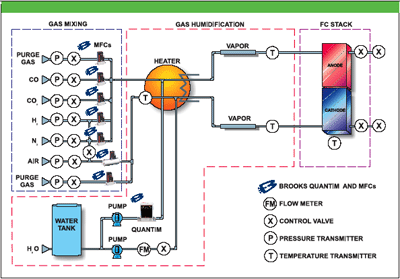|
Fuel cell engineers use test stands to simulate the performance of fuel cells. The challenge is to mimic reality and determine the optimum fuel mixture and temperature, while also examining failure mechanisms. Another objective is to test the performance of anode/cathode materials, catalysts, and membranes.
Fuel cell test stands consist of systems for mixing, delivering, and humidifying gases, all of which depend on reliable flow measurement and control. A typical test stand uses several thermal mass flow controllers (MFCs) of various flow rates to deliver the precise amount of blended gases to the fuel cell. Since the test stand must imitate normal operating conditions, these flow controllers must react to process signals quickly – much like a car accelerator – to provide a true test of the desired performance. In addition, the MFCs must have a broad turndown to mimic low and high fuel consumption rates. Many fuel cell test stands use MFCs that do not have the performance capabilities to adequately test fuel cells.
THE BROOKS SOLUTION
The use of Brooks digital mass flow controllers in the gas blending/delivery system improves response time from several seconds to less than 1 second vs. other MFCs. Brooks digital MFCs also provide notable improvement in turndown. Turndown of other devices, when measured as control range staying within 2% of rate accuracy, is between 2:1 and 12:1. Brooks MFCs have been tested to 30:1. Overall accuracy and repeatability are also improved with Brooks digital MFCs. They can store up to 10 gas calibration curves, making them more flexible.

The enhanced response time, repeatability and accuracy of Brooks digital MFCs deliver more rigorous and consistent tests, and require fewer tests to achieve the same results. Greater turndown and multicalibrations yield savings by using fewer MFCs per test stand, and provide more room for other equipment. This in turn saves maintenance and inventory.

The humidification system must respond accurately to changes in gas flow and/or changes in humidity set points to deliver the desired humidity to the fuel cell. The Brooks QUANTIM® mass flow controller is used here to deliver the correct amount of fluid to maintain the desired humidity level. The QUANTIM MFC is extremely accurate and inherently fast. With an accuracy of +/- 0.2% of rate and a response time of less than 1 second, QUANTIM is ideally suited for this application.
|



